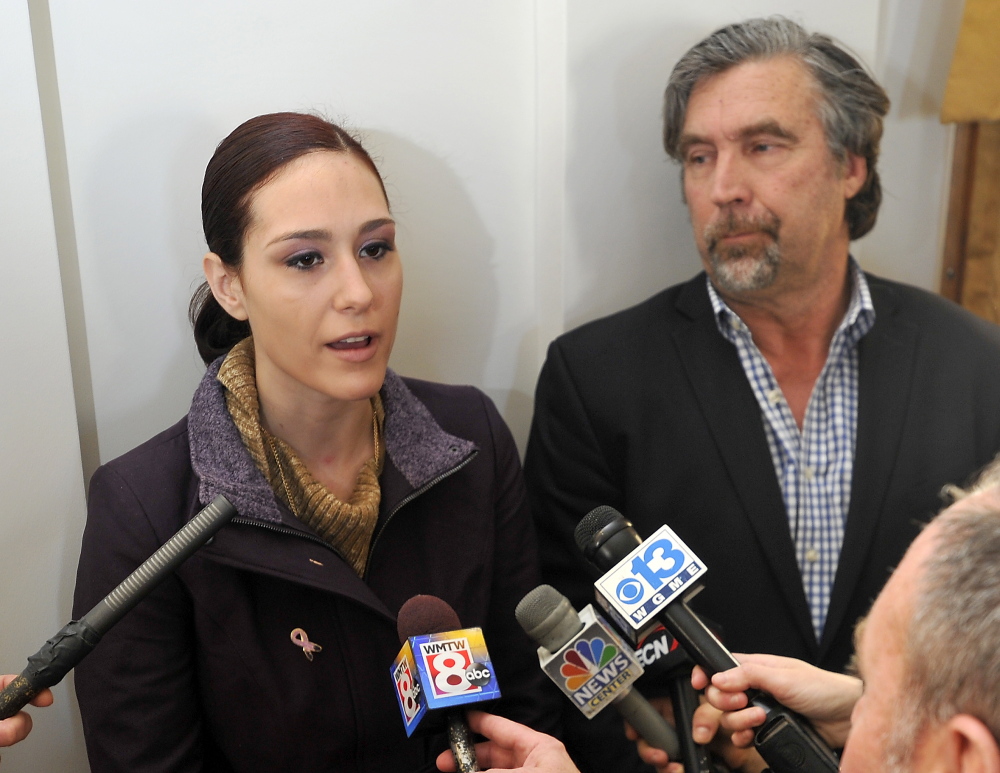A fire on Noyes Street in Portland that killed six people in November was caused by a discarded cigarette butt that ignited a building where the smoke detectors had been disabled, investigators said Wednesday.
Four lawsuits have been filed against the building’s owner on behalf of the victims, and a fifth is pending.
Portland Fire Chief Jerome LaMoria said Wednesday morning that a burning cigarette discarded into a plastic receptacle started the early morning fire at 20-24 Noyes St. on Nov. 1. He also said that the building had no working smoke detectors, which might have alerted the residents sleeping inside. Investigators didn’t say who disabled the smoke detectors.
Five people died of smoke inhalation on the second and third floors of the duplex. One of them, David Bragdon Jr., was found near a window apparently overcome as he tried to escape, according to court papers.
A sixth victim, Steven Summers, rushed from the building but was badly burned and died four days later from his injuries.
His widow, Ashley Summers, attended Wednesday’s news conference at City Hall along with her attorney, Thomas Hallett. She said the investigation’s results confirmed what she had learned about the fire.
“If those alarms would have gone off, they (residents and visitors) would have got out,” Summers said. She faults the landlord, Gregory Nisbet, for not making sure the smoke alarms were working and that the building was otherwise safe.
“The codes aren’t incredibly strenuous. They shouldn’t be that hard to keep up with,” Summers said. She said she hopes landlords and tenants will learn from the tragedy and take steps to make sure their buildings are safe.
State Fire Marshal Joe Thomas said investigators found evidence that the hard-wired smoke detectors had been disconnected.
“There were wires hanging out of walls where smoke detectors were supposed to be,” Thomas said. “Through some of the interviews, tenants were indicating … different detectors would go off at different times and eventually they just started getting disabled instead of taking care of them appropriately.”
A landlord is required by law to make sure smoke detectors are working in rental units, and if residents disable them, the landlord can ask police to charge the tenant with criminal mischief, he said.
CHECKING FOR CRIMINAL CULPABILITY
LaMoria announced the results of the investigation after learning that the Bureau of Alcohol, Tobacco, Firearms and Explosives had confirmed investigators’ theory of how the fire started. The complete investigation results were not released because they will be turned over to prosecutors to determine whether to bring any criminal charges.
“While the actual cause is not criminal, the full report is being forwarded to the District Attorney’s Office for review,” LaMoria said. Prosecutors will be looking to determine whether criminal culpability occurred in the management of the property.
Criminal liability is much harder to prove than civil liability, said Jim Burke, clinical law professor at the University of Maine School of Law. To find someone criminally responsible would require at least a conscious disregard of the risks – like speeding on an icy road, he said.
Civil negligence requires showing that it is more likely than not that the defendant failed to be aware of a risk or ignored a risk, and that negligence caused harm to the person bringing the suit.
“A negligence suit says you have a duty to your tenant not to unreasonably expose them to the risk of harm,” Burke said, noting that he could not comment on the specifics of the Noyes Street case. “If you don’t have fire alarms that are working, that could be negligence.”
DID LANDLORD ADHERE TO CODES?
Wednesday’s announcement of a cause and origin of the fire has little implication for the civil suits brought against Nisbet because investigators said early on that the fire appeared accidental. However, their definitive statement that no smoke detectors were working and that one of the exits from the second floor was blocked by furniture could bear on Nisbet’s liability.
“Nobody was ever claiming the landlord started the fire. … The duties of the landlord to make sure the fire codes are followed, that is going to be the big issue here, not so much the cause of the fire, but why did people have to die in this fire given the requirements there be smoke detectors and escape exits,” said Terrance Duddy, the attorney representing the estate of Nicole Finlay.
A message left for Nisbet’s attorney seeking comment was not returned Wednesday night.
It is unlikely the lawsuits against Nisbet will go to trial. Increasingly, lawsuits are being settled between the parties who don’t want to run the risk of a trial, Burke said. Also, Nisbet appears to have few assets. The Noyes Street building was insured for $300,000, but it has since been taken over by the bank. A Superior Court judge has frozen Nisbet’s other assets, which include a Dartmouth Street apartment building that also is in foreclosure.
VICTIMS’ FAMILIES SEEKING ‘JUSTICE’
But the lawsuits are about more than just money, say attorneys for the families whose loved ones died in the blaze.
“They’re looking for answers and looking for justice,” said Steven Silin, the attorney representing the family of David Bragdon Jr.
The amount sought in a motion to attach the defendant’s assets is based on the dead person’s potential for future earnings, survivors’ loss of the person’s love and affection, and the conscious pain and suffering the person experienced.
“It’s fair to say one can imagine few worse ways to leave this world than to be overcome by fire and smoke and be unable to get out,” Silin said.
Civil judgments remain in force for 20 years, though they can be discharged in bankruptcy court, said Burke, the law professor.
Silin, who said the cases are likely to be joined together, is looking forward to seeing the full report from the ATF Fire Research Lab.
“We’re waiting to hear more, not just about the cause and origin, but some of the confirmation of the violations that may have contributed to the deaths of these young people,” he said.
BUTT RECEPTACLE NEAR COMBUSTIBLES
Fire Marshal Thomas said that although the fire was accidental, human actions contributed to its start and its severity.
Besides the disabling of the smoke detectors, the front door was left open, allowing the fire to spread quickly inside the house and block the front doorway.
Thomas said the cigarette receptacle was a tall, plastic hollow post designed as a receptacle for butts. The metal can that is supposed to be at the base of the plastic container had been removed to be used as a second ashtray, allowing the plastic to ignite and melt on top of the wooden floor of the porch.
A blue plastic recyclables container, as well as possibly other debris, was located alongside the ash receptacle, he said. The couch and a chair on the porch also fueled the fire.
One of the exits leading from the second floor was blocked by furniture, he said. The three people who did escape climbed out a second-floor window.
“The location of the fire and the time of day and the amount of combustibles present all impacted the speed of this fire and led to a larger life loss, and along with that … there were blocked exits in the home and there was no evidence of a working smoke detector,” LaMoria said.
Improperly discarded smoking materials is the most common cause of fire deaths in the United States, he said.
LaMoria said investigators will never know who discarded the fateful cigarette butt.
MORE SUITS, BUILDING INSPECTIONS
The severity of the Noyes Street fire led the city to seek access to Nisbet’s other rental properties. Inspectors initially were unable to get voluntary access to the buildings, but obtained an inspection warrant Tuesday for 186-188 Dartmouth St. and 124 Noyes St. The buildings were inspected Tuesday and the city is evaluating violations it found and possible enforcement actions.
City officials said the investigative report will be used by the task force set up in the wake of the fire to review the city’s safety regimen for rental properties.
On Wednesday, a lawsuit was filed against Nisbet seeking $4 million on behalf of David Bragdon Jr.’s family. The lawsuit on behalf of Steven Summers’ widow and two young children seeks $1.7 million in damages. Earlier this month, the family of Ashley Thomas filed a lawsuit seeking $2 million, and the family of Nicole Finlay filed for $1.4 million.
The lawsuits rely on the same interviews and conclusions submitted with the first suit, which was brought by Summers.
Bradford Pattershall, an attorney representing the family of Christopher Conlee, said he plans to bring suit some time in the next two weeks.
LaMoria said anyone with questions about fire safety can call: 482-LIFE.
David Hench can be contacted at 791-6327 or at:
Twitter: @Mainehenchman
Send questions/comments to the editors.




